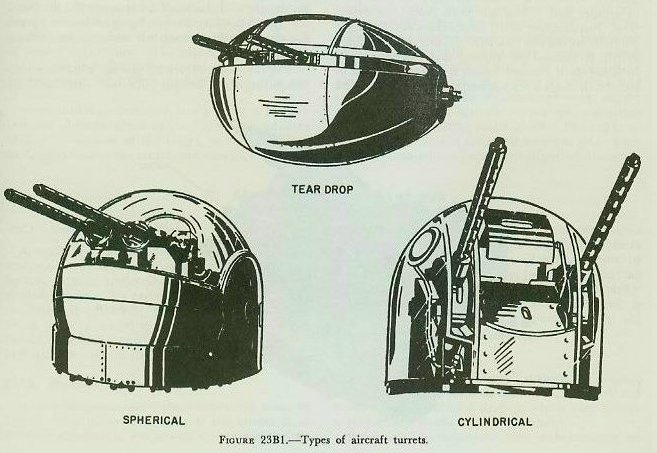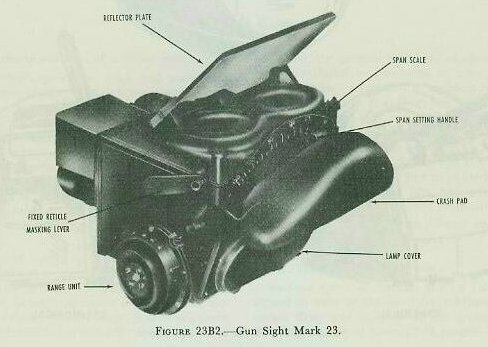| NAVAL ORDNANCE AND GUNNERY, VOLUME 2 CHAPTER 23 AIRCRAFT FIRE CONTROL |
| HOME INDEX Chapter 23 Aircraft fire control A. Introduction B. Aircraft gunnery C. Aircraft weapon systems D. Theory of horizontal bombing E. Other bombing problems F. Rocketry |
| B. Aircraft Gunnery 23B1. The general problem of aviation gunnery Because aircraft speeds are high and constantly tend to become higher, actual firing time in any attack is limited to seconds. For this reason it is essential that rate of fire be rapid, so that there is reasonable probability of scoring enough hits to do effective damage. High projectile velocity is also desirable, to reduce time of flight and thereby minimize the effect of many variables which tend to detract from accuracy. It must also be remembered that performance of the airplane itself is a factor in the effective employment of the plane’s guns. Recognition of targets is one of the most critical items in air combat, because it is the key to making initial estimates of range, speed, and mission. A common error in aerial gunnery is to open fire before the target comes within range, and to continue fire when the target is beyond effective range. In fact, the general problems of aircraft gunnery can be reduced to questions of who, where, and when. “Who” refers to the problem of whether a potential target is friend or foe, and if foe, what the type of plane may be. “Where” is the problem of target location relative to the gun, which in modern installations may be solved or largely solved by automatic means. “When” is the problem of when to open and cease fire to provide maximum probability of obtaining hits, yet maintain necessary conservation of a limited ammunition supply. A typical aircraft gun, the 20-mm automatic gun Mark 3, is discussed in chapter 9. 23B2. Types of aircraft turrets Various types of aircraft turrets have been designed in view of the need for minimizing aerodynamic drag, and in view of the desire to provide an adequate arc of coverage at various locations on the aircraft. Three types of aircraft turrets are (1) the spherical or ball type, (2) the cylindrical type, and (3) the teardrop type. All three types may incorporate power drives consisting of amplidyne or thyratron units. They are shown in figure 23B1. |
 |
| In the ball type of turret, the entire turret moves in train and elevation about axes which intersect at the center of the sphere. Such turrets are suitable for location in the nose, tail, or lower centerline of the aircraft. The cylindrical type of turret moves about its own axis in train, but only its guns and sights move in elevation. Such turrets ordinarily are located in the tail or upper and lower centerlines of the aircraft. The teardrop turret has a streamlined shape, with its axis, which is the chord of the streamlined arc, parallel to the fore-and-aft centerline of the plane. The tear-drop type rotates about its own axis in elevation, but only the guns and sights move in train. This type is suitable for waist installation. In larger airplanes, turrets are installed to provide full defensive coverage. Locations on various planes commonly include the nose, tail, upper and lower deck, and side waist positions. In high-speed planes there is a tendency to sacrifice frontal coverage in favor of good tail coverage, since attack is more probable in the latter area. In smaller planes, fixed, forward-firing guns may be relied upon to provide frontal coverage. 23B3. Fixed and free gunnery In spite of the rapid development of aircraft rockets and air-to-air missiles, fixed, forward-firing guns are still an important part of the armament of fighter and interceptor planes. They serve as semi-defensive armament on small attack-type planes, and as accessory armament on some larger attack planes when strong gun concentration is desired for strafing. Such guns usually are aligned on the ground by a boresight technique, so that they coincide with the line of flight of the airplane under combat conditions. The angle of attack of the plane varies with its speed and other factors; however, variations in angle of attack within the range of combat speeds usually are not large enough to affect gunfire accuracy seriously. If time of flight of the projectile were zero, it would merely be necessary to attack at the appropriate speed, point the plane at the target, and score hits. However, since attack angle may vary and the projectile’s time of flight to the target usually is in the order of 1 to 3 seconds, it is ordinarily necessary to make various allowances, such as lead provided to compensate for target motion. Maximum lead is required when the attacking plane is on the beam of the target. The problem of fire control for free guns is somewhat more complex. This is because the free gun is not aligned with the air stream past the plane, but may take an infinite number of angles thereto. In addition to correcting for target speed and course, it is necessary to correct for own ship’s velocity vector relative to the gun position. The use of simple ring sights (noncomputing) has proved to be fairly effective in fixed, forward-firing gunnery, but is largely ineffective in free gunnery except at point-blank ranges. 23B4. Sights used in aerial gunnery At the beginning of World War II, noncomputing ring sights and telescopic sights were in common use. They proved to be relatively inadequate, especially in the case of free gunnery, because pilot or gunner had to estimate both range and deflection. Introduction of the illuminated reflector sight partially solved the problem. In this sight a lighted reticle is focused on infinity, and appears superimposed on the target, which is viewed by pilot or gunner through a transparent reflector plate. This sight made it possible to view the target readily, day or night, and permitted unrestricted movement of the head without introducing parallax. But the pilot or gunner still had to estimate his lead. In the course of World War II, several types of lead-computing sights were developed, all based upon the use of a gyroscopic element to measure angular movement of the line of sight between gunner and target and thus make possible the introduction of the proper lead angle. This type of sight is used on both fixed and free gun mounts. It includes a collimated reflector-type sight, and a gyro-controlled reticle superimposed on a fixed, boresighted reticle. Manual inputs include range and wing span of target. Own altitude, own air speed, and relative angular velocity of the target are computed automatically. Once wing span of the target has been estimated and set in, the gunner keeps the target framed in the gyro-controlled reticle, using his range input to control the size of the reticle. The gunner must keep the target in the reticle and track smoothly, so that gyro precession incident to the tracking, modified by automatic inputs and ballistic corrections, will provide the proper lead. The principle of the lead-computing sight is discussed in chapter 26, the Mark 15 sight described therein being closest in operating detail to those described below and in volume III, chapter 2. The Gun Sight Mark 23 (see fig. 23B2) is a lead-computing sight designed for use with fixed, forward-firing guns. It omits components which compute windage and the effect of own plane’s motion. It is effective in straight runs, but does not provide for centrifugal-force effects incident to aircraft maneuvers. A typical lead-computing sight designed for free guns is described in volume III, chapter 23. |
 |
| 23B5. Tactical employment of aircraft guns The tactical use of aircraft guns differs, depending upon whether primary armament of the plane consists of fixed, forward-firing guns on the one hand, or free guns on the other. Tactical use, however, is not exclusively dependent upon armament. In any case, it is virtually essential that personnel be able to recognize an enemy target as to type, and make a reasonably accurate estimate as to range. The primary mission of fighter-plane groups often is the interception and destruction of enemy bombers before the latter have opportunity to reach their targets. The situation may be complicated by the presence of an enemy fighter escort for protection of the bombers, which necessitates either an initial attack upon the fighter escort, or simultaneous attack upon escort and bombers. In attacking a bomber, the pilot of a fighter plane with fixed, forward-firing guns is faced by the fact that position at the time the gunnery run is begun is of utmost importance. The plane, pilot, and guns act as one coordinated weapon, which must be properly positioned from the beginning to the end of the run. Good initial position for attack upon a bomber includes altitude advantage, a location in advance of and to one side of the target, so that the pilot has a good view of the target, and enough maneuvering space to permit turning to close range and arriving at an open-fire point 20° to 30° forward of target’s beam. Such a position is advantageous in intercepting jet bombers when the speed differential between bomber and fighter is small. The breakaway after an attack should be as rapid and decisive as possible, because during this period enemy gunners have a chance to fire at the fighter plane unopposed. Ordinarily, however, the attack upon a bomber is not made by a single fighter plane, but is a coordinated attack made by several planes. Some of these planes may be able to make firing runs unopposed, because defending gunners are otherwise occupied. From the standpoint of bomber defense, some advantage is gained by flying in close formation, because fire from several planes can then be concentrated upon a single attacker. Ordinarily the plane commander designates the sector to be covered by each gunner. In most circumstances fire is withheld unless direct attack is made upon own plane, due to the necessity of conserving ammunition. Fighter-to-fighter combat, if conducted by only two opposed planes, is generally a series of maneuvers designed to gain position in the tail cone of the enemy, where he is undefended. Such encounters put a premium upon airplane maneuverability and pilot skill. The more common tactical approach is coordinated attack by a number of planes designed to take the enemy by surprise, and to establish local, even though temporary, superiority of numbers. Altitude advantage, a position up-sun from the enemy, and a position forward from the enemy, or in the direction he must go to complete his mission, are factors predisposing to success. |